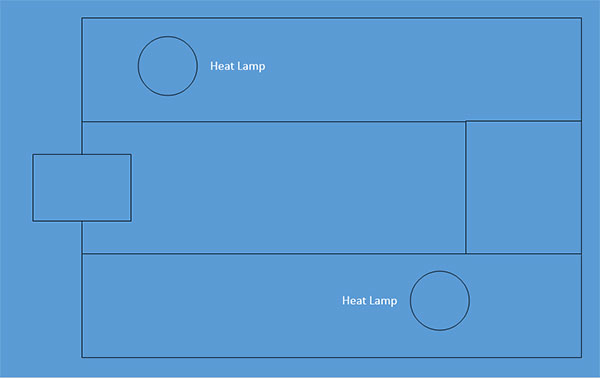Management and Care of Piglets
One of the most abrupt and major changes for any animal is its birth. The fetus goes from a parasitic existence, where its environmental and nutritional needs are provided by the dam in a sterile environment, to one in which piglet must fend for itself.Pigs are normally born either headfirst or rear feet first. Sometimes, a piglet will be covered by placental membrane upon expulsion, on such cases, this should be removed to prevent suffocation, otherwise leave the piglet by itself.
Here are some guides in caring and managing newly born piglets
Navel Cord Care
Do not clip the umbilical cord on newborn piglets immediately after expulsion. Such a procedure may create an avenue for disease organisms to enter the piglet's body. It will dry and fall off on its own. This usually happens about six hours after birth, although it may take longer for weak piglets. If a piglet is bleeding from the navel, stop the bleeding by tying clean string around the cord approximately 1-2 inch from the body. Disinfection of the base of the navel cord should be a routine practice to prevent, if not minimize problems later on (navel ill, greasy pig, arthritis).
Teeth Clipping
This procedure is performed, a few hours after birth. The needle teeth are often clipped to prevent damage to the udder of the sow and also to avoid fighting wounds among piglets. This can be done by cutting the sharp points of the teeth (8 teeth, 4 in the upper jaw and 4 in the lower jaw) using a tooth clipper or an electric wire cutter. Do not clip the teeth too close from the base to avoid hitting the gums as this may cause bleeding with subsequent infection.
Experts recommend that teeeth clipping be done at least 6 hours after birth so that the piglets can suck colostrum first.
Brooders
Piglets are more comfortable at a higher environmental temperature compared to sows. The ideal brooder temperature for piglets is from 30°C to 32°C. One hundred-watt electric bulbs could be used as heaters, especially during early morning (1:00-4:00 AM). Other types of heater are available in the market.
The right temperature for piglets is shown by their behavior. If piglets stay close to the sow or to the heat source or huddle together, the temperature is too low. If piglets stay close to the sow but stay away from the heat source and still huddle together, then the heat source might be too high. If piglets are evenly distributed in the pen and in the brooder, then the temperature is just right.
Rough hair coat may indicate sickness or cold temperature. Avoid drafty conditions since these have cooling effect on piglets. Always keep the brooder or creep area warm, dry and clean.
Arrangement of Heat Lamps for a Farrowing Sow
Colostrum
Human infants obtain immunoglobulin (proteins that help fight diseases) from their mothers through the placenta. The circulating antibodies in the mother's blood system move freely across the fetal membrane into the developing fetus. The type and extent of the mother's exposure to diseases will determine how protected the unborn infant is. The pig placenta does not allow the transfer of these antibodies.
When piglets consume colostrum, these specialized protein by-pass the stomach and are absorbed, through the intestinal lining, directly into the blood stream. All of a newborn piglet's immunity comes from the sow after birth. This is also called "passive immunity". The ability to passively absorb these immunoglobulin, intact without digestion, is lost after 36 hours of age. At this point, gut closure is said to take place. Colostrum ingested after this period is digested in the stomach by digestive enzymes.
It is extremely recommended that piglets suckle immediately after birth due to these reasons!
Fostering
If sows do not produce enough milk or have given birth to a large litter it is wise to transfer the whole litter or few of the piglets to a foster sow, as the case maybe. Fostering is best done to sows, which have farrowed 1 or 2 days earlier or later, if not on the same day. As a rule of thumb, always transfer or foster bigger piglets so they would have the advantage of fighting off new littermates. It is best done on sows of the same breed.
Crushing
Piglets crushed by the sow are commonly seen in most farms. Factors that may contribute to this are:
- Weak-legged sows, specially the hindlegs, tend to fall abruptly when lying down;
- Weak piglets that may not be able to get away quickly;
- Poor pen construction resulting to slippery flooring and improperly made farrowing hurdles;
- Inadequate heating resulting to huddling near the sow;
- Poor water supply of the sows resulting to frequent standing and lying down to drink
- Disturbance in the farrowing unit causing excitement on the part of the sow
This illustration shows the relationship of the different factors enumerated. Clearly, management of crushing incidence needs careful assessment of environmental factors affecting the piglets and the sow.
Splayed legs
Piglets are sometimes born with weak leg muscles and are not able to stand and walk properly. Splay-legged piglets can be still be corrected by a special leg taping or tying technique. Slippery floor and piglets exposed to very low temperature predispose occurrence of splayed legs.
Slippery floors and piglets exposed to low temperature predispose occurrence of splayed legs.
Splayed legs can be remedied by taping the legs together to support movement of piglet. Normally, a piglet can stand on its own within three days. If not, we can dispose the affected piglet.













0 Comments